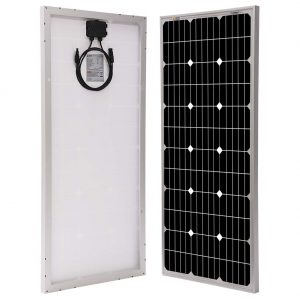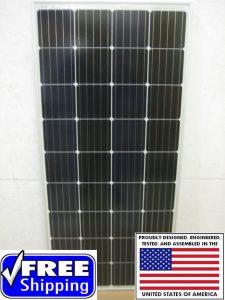Lots of options when it comes to solar panels. The key factors you’ll want to look at are:
Voltage
Solar panels come in various voltages. If you’re running a 12v system with a MPPT charge controller, you’re pretty flexible on what panels you get. Most panels are designed for 12v or 24v nominal systems. The voltages of the panels are actually a significant bit higher than their “nominal” voltages, but that’s necessary so they can actually charge your batteries without requiring an up-converter.
Series or Parallel (or both)?
For most situations, panels will be wired in parallel. This sums the total number of amps while keeping the voltage at the panel rating. This is a great solution for most rigs as it helps with mitigating shading issues on panels and is simple to wire up.
Series connections may be required if you’re running a 24v or 48v (or higher) system to get the panels up to the required voltage you need to change the system. Series connections can also be helpful if you’re running a very large array and want to reduce the number of cable runs or are running into restrictions on how many amps you can push through your cabling. Higher voltages are technically more efficient as well, but that’s a very small factor.
How your system will be wired up will depend on your needs and your situation.
Rigid or Flexible
For most rooftop installations, rigid panels are the right way to go. They’re less expensive per watt and they last significantly longer.
Flexible panels can be handy if you have a particularly difficult shape or need the ability to easily remove and re-deploy your panel in various places.
Brand
There’s a whole variety of brands out there, with prices to match. In most cases, the choice of brand is of little importance, in my experience. Once the panel is installed an functional, it’s pretty much going to stay that way for the life of your RV.
Size
Just about all solar panels are rectangular, so it’s a matter of figuring out what will fit on your roof with the least shading issues. If your goal is to get 1,000 watts of solar on your roof, you might be better served by (10) 100-watt panels strategically placed instead of (4) 250-watt panels.
Monocrystalline (Mono) or Polycrystalline (Poly)?
Solar panels can be constructed in basically one of two ways, Monocrystalline or Polycrystalline. Mono panels are slightly less efficient at converting sunlight, are slightly more susceptible to heat, and cost less. Poly panels are slightly more efficient, better at handling heat, and cost a little bit more. The differences between these two types are pretty minimal, but if I have the option, I’ll choose Poly for an RV.
Newpowa
Watts: 100
Price: Low ($77.57 on their website)
Cell Type: Mono
Dimensions: 39.8″ × 26.57″
Link: NewPowa, Amazon
I like the wire coloring on the back of the panel. Instead of two black wires, they made one red. MC4 connectors are supposed to be idiot-proof, but sometimes when you’re on the roof sweating in the sun, it’s nice to have that little bit of simplicity.
Richsolar
Watts: 100
Price: Standard ($89.99)
Cell Type: Mono
Dimensions: 46.5″ x 20.1″
Link: RichSolar, Amazon
All black panel. Very slick looking! If you’re going for stealth, this is great for you. I personally wonder if it’ll heat up more than their silver cousins but it’s probably a minimal concern.
Renogy
Watts: 100
Price: High ($119.99)
Cell Type: Mono
Dimensions: 47.3″ x 21.3″
Link: Amazon
If you really want the name brand, or just want to pay more, Renogy is an option for you. I’m not seeing anything special about this panel that makes it significantly more expensive than its competition.
Hightec Solar
Watts: 200
Price: Low (per watt) ($165.00)
Cell Type: Mono
Dimensions: 58.7″ x 26.625″
Link: eBay
There’s deals to be had out there if you’re willing to look around. Here’s an American manufacturer that’s selling what looks like a great panel at a very reasonable rate.
Q Cells
Watts: 395
Price: Low (per watt) ($260.00)
Cell Type: Mono
Dimensions: 79.3″ × 39.4″
Link: altEstore
Just to give you an idea of other options out there if you’ve got the roof space, this is an awesome panel. 395 watts per panel is just amazing! It also scores incredibly high with 19.6% efficiency. If I was building my rig today, this is what I would install.
Renogy Deployable Panels
Watts: 100
Price: High (per watt) ($196.00)
Cell Type: Mono
Link: Amazon
If you like to park in the shade, a deployable panel can be a good option for you. Set it out when needed, bring it back in when you leave. Remember to rotate the panel during the day as the sun moves! These panels are far more expensive per watt than others listed on this page, but they are portable and don’t have to be permanently mounted.







